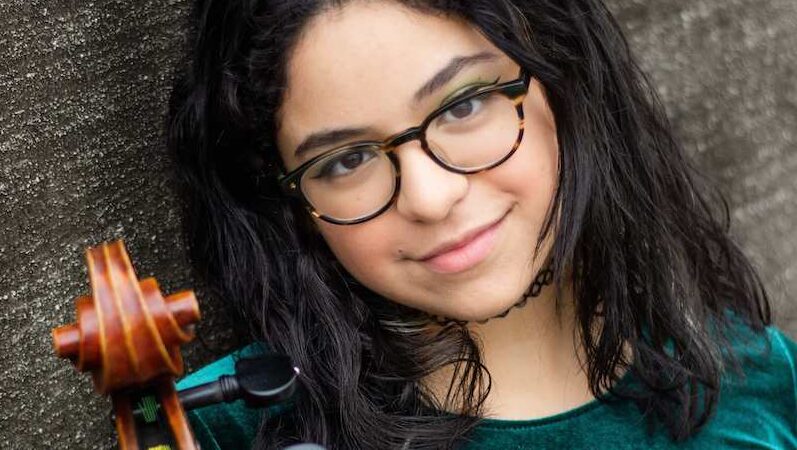Symphonie Fantastique


Symphonie Fantastique
Program
Saturday October 15, 2022, 7:30 p.m.
Jack H. Miller Center for Musical Arts, Hope College
Cold Mountain Suite
Jennifer Higdon (b. 1962)
Concertino for Cello and String Orchestra
Esteban Benzecry (b. 1970)
1. Allegro
2. Intermezzo dramatico: Largo Misterioso
3. Toccata: Allegro
Adalus Low-Manzini, cello
Intermission
Symphonie Fantastique, op. 14
Hector Berlioz (1803-1869)
1. Reveries, Passions
2. A Ball
3. Scene in the Country
4. March to the Scaffold
5. Dream of a Witches' Sabbath
Tickets: Adults - $25, Students through college - $5
Season Ticket Series
Saturday October 15, 2022, 7:30 p.m.
Jack H. Miller Center for Musical Arts, Hope College
Tickets: Adults - $25, Students through college - $5
Season Ticket Series
The concert opens with a new piece by award-winning composer Jennifer Higdon commissioned by a consortium of orchestras. A young Venezuelan cellist and Sphinx competition artist, Adalus Low-Manzini, will perform a cello concerto by Argentinian composer Esteban Benzecry. Rounding out the program is Berlioz’s masterpiece, Symphonie Fantastique.
Learn more about the music…
We will be hosting not only the Classical Chat series at Freedom Village, but also Pre-Concert Talks! Details below:
Classical Chats at Freedom Village: These informative and fun talks are led by Johannes Müller-Stosch and take place at 3:00pm on the Thursday before each Classics concert. (Freedom Village, 6th Floor Auditorium, 145 Columbia Ave.)
Pre-Concert Talks: These talks, led by Johannes Müller-Stosch and Amanda Dykhouse, will be online this year under the "Pre-Concert Talk" Tab. There are opportunities for you to ask questions about upcoming programs on that tab. We look forward to resuming live Pre-Concert Talks when the pandemic lessens.
New to the Symphony? Check out the Frequently Asked Question page…
Parking Map at the Miller Center
Holland Symphony Orchestra will reserve and monitor Lot 40 for handicapped parking. The faculty parking lots are available for parking after 5pm

Cold Mountain Suite
Jennifer Higdon
Born: December 31, 1962, Brooklyn, NY
Written: 2012-2014
Opera Premiere: August 1, 2015, Santa Fe Opera
Suite Premiere: Fall 2021, Delaware Symphony
Approximate duration: 19 minutes
Instrumentation: 2 flutes, 2 oboes, 2 clarinets, 2 bassoons, 4 French horns, 3 trumpets, 3 trombones, 1 tuba, 3 percussionists (bass drum, brake drum, Chinese cymbal, crotales, glockenspiel, suspended cymbal, tom-tom, vibraphone), strings
Jennifer Higdon is one of America’s most acclaimed figures in contemporary classical music, receiving the 2010 Pulitzer Prize in Music for her Violin Concerto, a 2010 Grammy for her Percussion Concerto, a 2018 Grammy for her Viola Concerto and, most recently, a 2020 Grammy for her Harp Concerto. Higdon’s first opera, Cold Mountain, won the International Opera Award for Best World Premiere and the opera recording was nominated for two Grammy awards. Most recently, she was inducted into membership in the American Academy of Arts and Letters. Higdon enjoys several hundred performances a year of her works and her works have been recorded on more than seventy CDs. Her music is published exclusively by Lawdon Press.
Cold Mountain was commissioned by opera companies in Santa Fe, Philadelphia, and Minnesota. It is based on the 1997 novel by Charles Frazier. The libretto is by Gene Scheer. Higdon, who grew up in the Appalachian region of the United States, helped refine the dialogue. She writes, "I helped Gene 'southernize' the libretto. Gene's from New York, and he wasn't sure how to shape the language for the characters, so I took care of it. Those speech patterns felt very familiar.” The opera is set in the American Civil War. It tells the story of a wounded Confederate soldier who deserted the Confederate army and faced a difficult journey home to his beloved, while she struggled for survival as she waited for the war to end.
Cold Mountain Suite is part of a commissioning project organized by New Music for America, a project of the League of American Orchestras. In these projects, a consortium of small budget orchestras, at least one in each state, comes together to commission a work from a major American composer. Each orchestra is asked to pay a small amount to participate. It is a meaningful way for small orchestras, who could not afford to commission a work from a major composer, to participate in these projects and in the birth of new American music. This is the third time HSO has participated in these projects. HSO is proud to perform the Michigan premiere of this work!
There is no recording of this piece yet, since this is a premiere. To learn more about the opera, click here.
Concertino para violinchelo y orquesta de cuerdas (Concertino for Violoncello and String Orchestra)
Esteban Benzecry
Born: April 13, 1970, Lisbon, Portugal
Written: 1992
Premiered: October 13, 1992, Claudio Baraviera, cello, Orquestra de Camara Mayo, Buenos Aires, Argentina
Approximate duration: 15 minutes
Instrumentation: string orchestra
Esteban Benzecry was born to Argentine parents in Lisbon, Portugal. He grew up in Argentina and did his early music studies there. He moved to Paris in 1997 where he studied at the Conservatoire Superieur de Paris. There he won the "Premier Prix a l'unanimitè" in composition in 1999. As a composer, he has won a variety of prizes and awards in Argentina and in Europe. He has become known for music that is based on Latin American rhythms and draws on European contemporary music. He has been called an heir to Villa-Lobos and Ginastera due to his use of Latin American rhythms and melodies.
Benzecry wrote this piece for cello and string orchestra in 1992. It has three relatively short movements. The first movement is fast and rhythmic, with a lot of two-against-three rhythms that are a hallmark of Latin American music. The slow movement opens mysteriously, as the cello explores melodies above muted and fluttering string sounds. Here Benzecry explores the low, melancholy range of the cello. The third movement, another fast and energetic showcase, features a lot of rapid dialogue between the soloist and the orchestra. Rapidly changing meters, with measures in five, six, or seven beats, keep listeners on their toes in this joyful display of virtuosity.
Holland Symphony and Adalus Low-Manzini are proud to present the U.S. premiere of this piece!
To listen to the first movement, click here.
To listen to the second movement, click here.
To listen to the third movement, click here.
Symphonie Fantastique
Hector Berlioz
Born: December 11, 1803, La Côte-Saint-André, Isère, France
Died: March 8, 1869, Paris, France
Written: 1829-30, revised 1832
Premiered: December 5, 1830, Paris
Approximate duration: 52 minutes
Instrumentation: 2 flutes (one doubling piccolo), 2 oboes (one doubling English horn), 2 clarinets (one doubling e-flat clarinet), 4 bassoons, 4 French horns, 2 trumpets, 2 cornets, 3 trombones, 2 tubas, timpani and percussion (bass drum, snare drum, cymbals, low‑pitched bells), 2 harps, and strings
Music donated by Mark Dykstra.
Hector Berlioz wrote his Symphonie Fantastique six years after the premiere of Beethoven’s ninth symphony, but the two pieces sound worlds and centuries apart.
Berlioz had a very different musical upbringing from most composers. He had a few flute and guitar lessons as a child in the small town where they lived near Grenoble, in the Alps, but he never became proficient at an instrument as a child. He didn’t know traditional music theory. His father was a doctor and wanted Berlioz to follow in his footsteps. He studied medicine in Paris but hated it, so he pursued private music instruction. In 1826 he entered the composition program at the Paris Conservatory. On his fourth attempt he won the coveted Prix de Rome, in 1830, for his cantata La Mort de Sardanapale, a lost and forgotten piece. By that point Berlioz had already composed his first symphony, the Symphonie Fantastique. Many musicologists feel that Berlioz’s Symphonie Fantastique is the most original first symphony ever written.
Symphonie Fantastique owes its existence to a theatrical performance Berlioz attended on September 11, 1827. An English touring company was performing Shakespeare’s Hamlet. One of the leading roles, Ophelia, was played by Harriet Smithson, a twenty-seven-year-old Irish actress. Berlioz fell instantly and completely in love with her, though they did not meet at that time. He spoke almost no English and she spoke almost no French, yet he wrote to her incessantly when the touring company left Paris. He read a French translation of Hamlet repeatedly. Gossip about affairs between Smithson and others in the company only fueled his wildly passionate feelings for her.
Ultimately the pair met at the end of 1832. After a brief courtship, and despite the fact that they could hardly communicate, they married. The marriage lasted only twelve years.
Smithson became such a vivid presence in Berlioz’s mind that she took the form of a melody, and Berlioz began writing a symphony about Smithson as portrayed by that melody. Her melody, which Berlioz called the “idée fixe,” is the central character in the symphony and its dramatic plot. Berlioz presents the melody in a variety of creative ways, coloring it with different instruments and surrounding textures. He wanted his intentions to be completely clear, so he wrote a detailed program for this work, complete with all capital letters when he felt that was necessary. He published these details (all the text below) with the score in 1845 and claimed this narration was “indispensable for a complete understanding of the dramatic outline of the work.”
The composer's aim has been to develop, to the extent that they have musical possibilities, various situations in the life of an artist. The plan of the instrumental drama, which is deprived of the help of words, needs to be outlined in advance. The following program should therefore be thought of like the spoken text of an opera, serving to introduce the musical movements, whose character and expression it calls into being.
Part One: Reveries, Passions — The author imagines that a young musician, afflicted with that moral disease that a well-known writer calls the vague des passions, sees for the first time a woman who embodies all the charms of the ideal being he has imagined in his dreams, and he falls desperately in love with her. Through an odd whim, whenever the beloved image appears before the mind’s eye of the artist, it is linked with a musical thought whose character, passionate but at the same time noble and shy, he finds similar to the one he attributes to his beloved. This melodic image and the model it reflects pursue him incessantly like a double idée fixe. That is the reason for the constant appearance, in every movement of the symphony, of the melody that begins the first Allegro. The passage from this state of melancholy reverie, interrupted by a few fits of groundless joy, to one of frenzied passion, with its gestures of fury, of jealousy, its return of tenderness, its tears, its religious consolations.
Part Two: A Ball — The artist finds himself in the most varied situations — in the midst of the TUMULT OF FESTIVITY, in the peaceful contemplation of the beauties of nature; but everywhere, in town, in the country, the beloved image appears before him and disturbs his peace of mind.
Part Three: Scene in the Fields — Finding himself one evening in the country, he hears in the distance two shepherds piping a ranz des vaches [a tune sung or played by a Swiss herdsman] in dialogue. This pastoral duet, the scenery, the quiet rustling of the trees gently brushed by the wind, the hopes he has recently found some reason to entertain — all concur in affording his heart an unaccustomed calm, and in giving a more cheerful color to his ideas. He reflects upon his isolation; he hopes that his loneliness will soon be over. — But what if she were deceiving him! — This mingling of hope and fear, form the subject of the Adagio. At the end, one of the shepherds again takes up the ranz des vaches; the other no longer replies.
Part Four: March to the Scaffold — Convinced that his love is unappreciated, the artist poisons himself with opium. The dose, too weak to kill him, plunges him into a sleep accompanied by the most horrible visions. He dreams that he has killed his beloved, that he is condemned and led to the scaffold, and that he is witnessing HIS OWN EXECUTION. The procession moves forward to the sounds of a march that is now somber and fierce, now brilliant and solemn, in which the muffled noise of heavy steps gives way without transition to the noisiest clamor. At the end of the march the first four measures of the IDÉE FIXE reappear.
Part Five: Dream of a Witches’ Sabbath — He sees himself at the sabbath, in the midst of a frightful troop of ghosts, sorcerers, monsters of every kind, come together for his funeral. Strange noises, groans, bursts of laughter, distant cries which other cries seem to answer. The beloved melody appears again, but it has lost its character of nobility and shyness; it is no more than a dance tune, mean, trivial, and grotesque: it is she, coming to join the sabbath. — A roar of joy at her arrival. — She takes part in the devilish orgy. — Funeral knell, burlesque parody of the DIES IRAE, SABBATH ROUND DANCE. The sabbath round and the Dies Irae are combined.
To listen to the Berlioz, click here.
Adalus Low-Manzini, cello
Adalus Low-Manzini is a young Venezuelan cellist based in Ann Arbor, Michigan, where she is pursuing a Master’ Degree in Cello Performance with Professor Amir Eldan at the University of Michigan. She was awarded the Sphinx Organization Scholarship which allows one Black or Latinx student every year to pursue a Master’s degree at UofM. She received her Bachelor's of Music in Cello Performance from Louisiana State University in May of 2021, where she studied with Professor Dennis Parker, a disciple of Janos Starker and Aldo Parisot. At present, Adalus carries out an important activity as a musician that includes both pedagogy, as well as chamber and orchestral music. From 2019 to 2021, Adalus was a cello teaching artist at Kids' Orchestra (an “El Sistema” inspired music program), where she taught music and cello to elementary and middle school children in the Baton Rouge area. This, combined with over five years of teaching experience in her Venezuela, Low-Manzini has been able to hold and maintain her private cello studio where she teaches students from preparatory to advanced levels between the ages of 8 and 20 all in the Ann Arbor area. She is the cellist of the Calista Quartet, an UofM string quartet she is part of along with fellow graduate students at the School of Music and with whom she performs for university events as well as Chamber Music Festivals like the Banff Center: Evolution: Quartet Program.
Adalus started her musical studies in the renowned musical program "El Sistema." There she had the opportunity to perform with maestros such as Gustavo Dudamel, in Venezuela, and with Sir Simon Rattle at the prestigious Salzburg Festival, in Austria. She has performed as a soloist with orchestras all throughout her home country and the US, including the Falcón Symphony Orchestra, the Teresa Carreño Symphony Orchestra, the Rapides Symphony Orchestra, the LSU Symphony Orchestra, among others. In 2015 she received the first prize at the I Festival Iberoamericano de Violoncello Competition. During that festival, she met two of her current mentors: Germán Marcano and Horacio Contreras; two people who have guided her throughout her musical journey ever since crossing paths.
In the summer of 2018, sponsored by Louisiana State University, she and her piano quintet Zizique attended “Orvieto Musica,” a prestigious chamber music festival held in central Italy. At that festival, the Zizique quintet was the only chamber music group that was awarded its own concert, which was held at the prominent Emilio Greco Museum in the city of Orvieto, with a program that included works by Brahms and Shostakovich. In addition to performing chamber music, Adalus has performed with different orchestras in the Louisiana and Michigan area, including the Baton Rouge Symphony, the Acadiana Symphony Orchestra, the Rapides Symphony Orchestra, and the Ann Arbor Symphony.
In 2018 and 2019, she attended the International Cello Institute (ICI) in Minnesota, where she received masterclasses from leading cello teachers such as Astrid Swcheen, Jens Peter Maitnz, and Anthony Ross. While in ICI, she met another important mentor: Anna Clift, who has consistently supported her through college applications, recitals, and more. From 2019 through 2022, she attended the renowned summer festival Center Stage Strings, a music program for emerging young artists held at the University of Michigan. In the summer of 2022, she won first prize in the CSS Contemporary Music Competition. In January 2019, Adalus won the Rapides Symphony Competition in the Youth Division and performed as a soloist with the same orchestra in Alexandria, Louisiana, in March of that year. In 2020, she won third place in the Louisiana State University concerto competition, allowing her to perform as a soloist with the university's orchestra in April of 2021.
One of Adalus' passions is the creation of educational and informative content for social media related to music. This has allowed her to hold positions such as the Video and Social Director for the International Cello Institute since 2019, and occasionally collaborate with the department of Creation of Digital Content of Strings of Latin America (SOLA) and The Sphinx Catalog of Latin American Cello Works, these last two initiatives of the Sphinx Organization. In addition to this, Adalus is an advocate for creating, commissioning and performing music by Latin American composers. In fact, this past year she received a grant to commission a cello solo work to be premiered in her Master’s degree recital by renowned Venezuelan composer Diana Arismendi. It is Adalus’ mission to keep commissioning works, especially by women Latin American composers, and in that way contribute to expanding the canon of cello music. In her free time, Adalus loves to swim, paint, and take pictures with her film cameras, as well as connecting and getting to know new people in the communities she visits.
Taras Krysa, Guest Conductor
The Ukrainian-born, American conductor Taras Krysa is establishing a reputation for innovative and thoughtful music-making throughout the United States and Europe. In addition to serving as the Director of Orchestras at UNLV, Mr. Krysa serves as the Music Director of Las Vegas Sinfonietta and just finished his tenure as the Music Director of Lviv Philharmonic Orchestra.
Mr. Krysa has appeared internationally with orchestras including the New World Symphony, Netherlands Symphony Orchestra, St. Petersburg Symphony, Moscow Soloists, Slovak Sinfonietta, Spoleto Festival Orchestra, Kiev Chamber Orchestra, Lublin Philharmonic Orchestra, Las Vegas Philharmonic Orchestra, Odessa Philharmonic Orchestra, and many others. In addition, Krysa led several European orchestras on tours in China, Germany and Netherlands, including appearances at the Concertgebouw Hall.
An accomplished violinist, he was a member of the St. Louis Symphony Orchestra and the New World Symphony Orchestra and continues to maintain an active career performing chamber music.
Krysa recently concluded his ninth season as the Artistic and Music Director of the Henderson Symphony Orchestra in Nevada. Under his leadership, the ensemble saw its audience expand ten-fold, and its concerts recognized as a treasured part of the cultural life of the community.
Mr. Krysa actively promotes new music and has made three critically acclaimed recordings for the Brilliant Classics label; two of which featured works by Mozart, and one a live recording of Freddie Mercury’s rock opera, Barcelona.
Krysa started his music studies in Moscow, Russia before moving with his family to the United States in 1989, where he continued his studies in violin and conducting at Manhattan School of Music, Indiana University and Northwestern University under the guidance of Albert Markov, Nelli Shkolnikova, Syvlya Rosenberg and Victor Yampolsky. Taras currently lives in Henderson NV, with his wife Nataliya and two adorable cats, Siegfried and Brungilda. In free time he enjoys skiing, surfing, playing viola and collecting stamps.
To listen to the pre-concert talk, click here.
- This event has passed.
Details
- Date:
- October 15, 2022
- Time:
-
7:30 pm - 9:30 pm
- Cost:
- $25
Venue
- Jack H. Miller Center for Musical Arts at Hope College
-
221 Columbia Ave.
Holland, MI 49423 United States + Google Map
Organizer
- Holland Symphony Orchestra






















